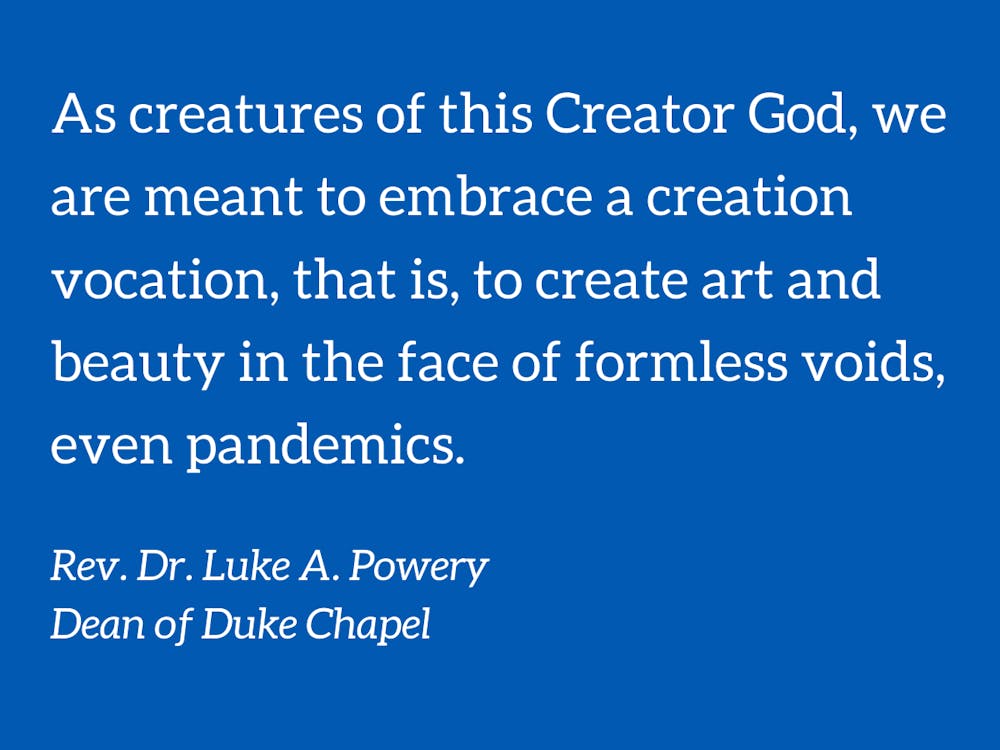Whether you’re 18 years old or the ripe age of 80, you have probably experienced loss in life, whether it is the end of a friendship, the loss of a parent or leaving a community. In the face of such emptiness, there is not a single answer for everyone but there is a response that all human beings can make. As creatures, we can create.
The Judeo-Christian religious tradition speaks of a beginning, a genesis, where there was a “formless void and darkness.” This formless void has been called chaos, disorder and disarray. In the face of this void, we hear that “In the beginning…God created.” God responds to formless chaos with creative activity to give meaning and shape to the world. The void is filled by the act of creation.
As creatures of this Creator God, we are meant to embrace a creation vocation, that is, to create art and beauty in the face of formless voids, even pandemics. It’s as if the void is calling us to create and make meaning out of the chaos.
In our day, the presence of the void comes in many forms. Poet Dorothy Thomas described one this way:
Yours was a lovely voice when you were young…
You’d whistle like a mockingbird.
The last of life was far from fair to you,
And not for it the first of life was made…
You called our names, saw others in our place.
You shook the clock to make it tell the time.
We thought that you had gone past all recall.
And mourned your spirit, lifted from its shell.
This poem may refer to one struggling with Alzheimer’s. The person is always there but not really always there. Their spirit has gone and flown away like a bird and all that remains is a shell of memories of the past. This is a cruel type of a void that many endure.
Another type of void is when a loved one dies but their bedroom stays intact like it was when they were alive; the feeling of a void at home can be very strong. Their photos, trophies, work desk, books, special blankets, favorite reading chair and their smell remain, but they are no longer there in body.
How do we respond to voids, the presence of an absence, like this one or others? How do we manage the mess?
One example I have seen is when there is a fatal car accident and in response someone creates a roadside memorial at the site of the death. These creative memorials can be crosses decorated with multicolored flowers, notes scribbled on small pieces of paper with expressions of love, poetry from family members, or photographs of good times from the past. Here on campus we have a war veteran memorial outside of Duke Divinity School, at which people place beautiful floral wreaths. This is creation in the face of a void.
I once saw another example in the gift shop of the Lutheran Church in Bethlehem. They sold glass angel ornaments that had been created out of shattered glass from bottles broken during battles between Israelis and Palestinians. From pieces of rubble, a sign of redemption. Beauty from brokenness. Creation out of so much chaos.
Many other examples are not hard to find—something new is always being created. Every day is a new creation, regardless of how bad the previous day was.
One thing these examples show is that creation takes time; it is a process like the divine creation in the beginning. It can’t be rushed or forced. It may take minutes, hours, days, years or a whole lifetime. But like the rhythm of poetry, it makes meaning in the face of tragedy, formlessness and chaos. And this is never-ending as creation is not a finished product but perpetual.
In this ongoing process of creation, where is the void you see? And what will you create in response? What beauty will you shape out of the chaos? This is our creation vocation as human creatures. It is a vocation that should never go on vacation.
The Rev. Dr. Luke A. Powery is the Dean of Duke Chapel. His column runs on alternate Mondays.
Get The Chronicle straight to your inbox
Signup for our weekly newsletter. Cancel at any time.

